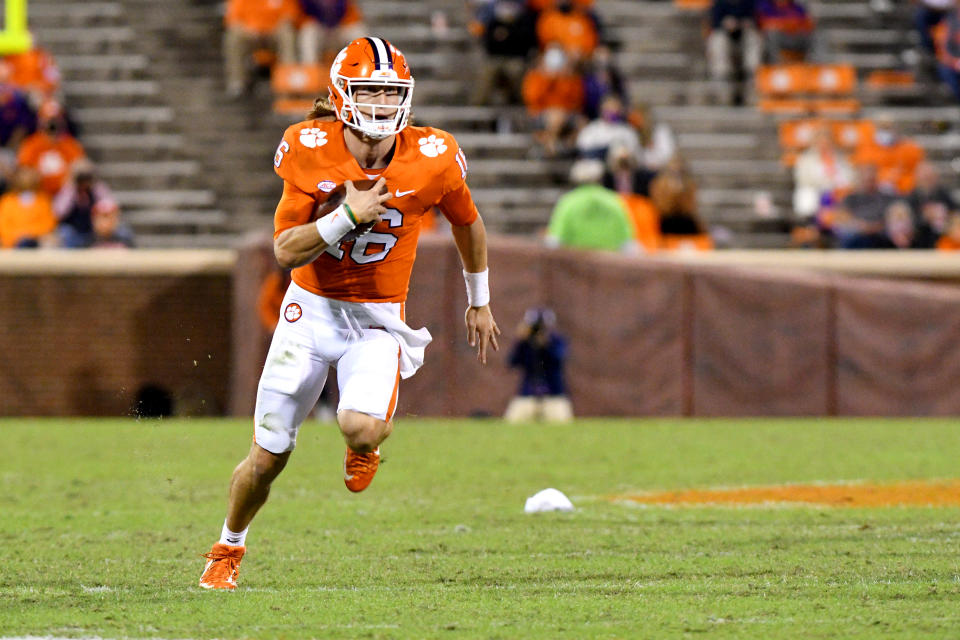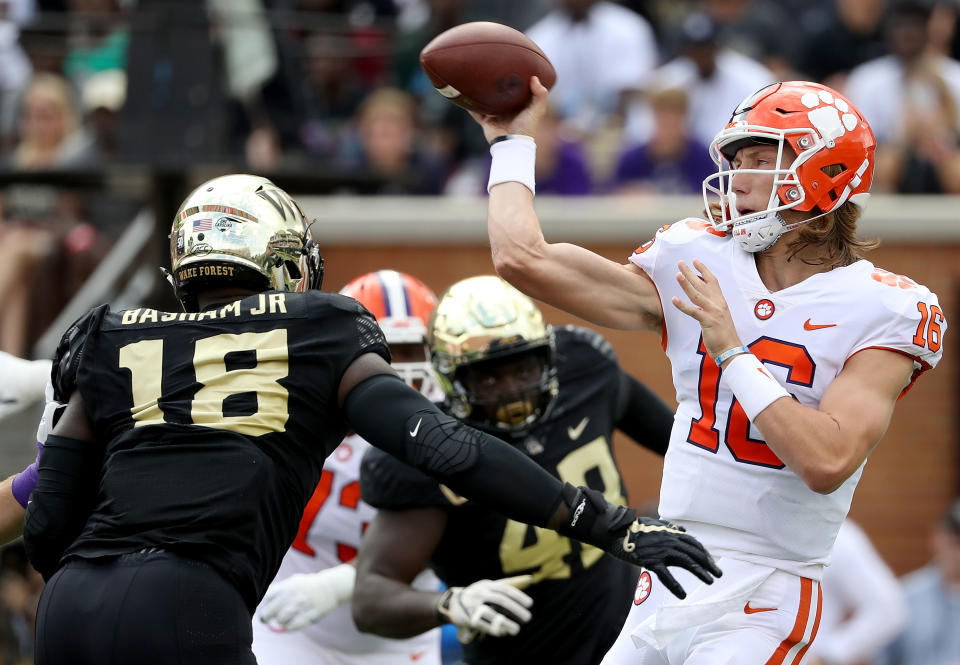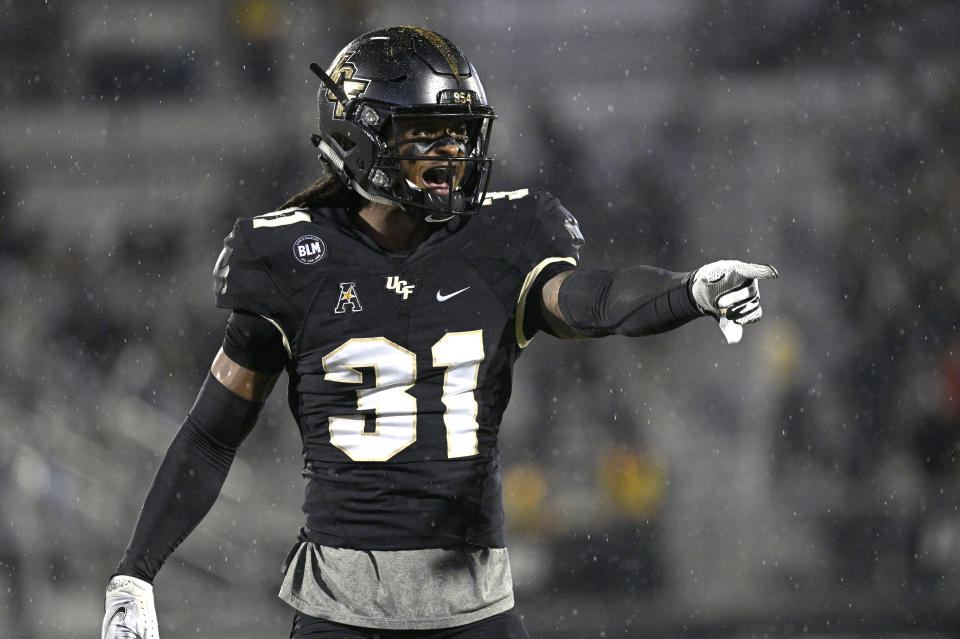NFL draft makeover: Assuming Jets land Trevor Lawrence, what else do they need?
Every week during the 2020 NFL season, we’re going to — just being honest here — overreact to what we’ve seen on the field the previous Sunday and start projecting NFL draft prospects to teams that might need help at certain spots.
Think of it as a mini one-team mock draft, with early (Rounds 1-2), middle (Rounds 3-5) and late (Round 6 and later) prospects at each team’s respective position of concern.
This week’s NFL draft makeover is the New York Jets. They might land the first overall pick, but what other pieces can help rebuild this train wreck?

The New York Jets led 10-0 Sunday over the Buffalo Bills and held a lead late into the third quarter. They remained within one score throughout the game but ended up falling 18-10 after the offense — are you ready for this? — netted 4 offensive yards in the second half.
Four.
Sam Darnold made his triumphant return, throwing two interceptions and fumbling once, although the Jets recovered it. On the season, he has three touchdown passes and six picks in five starts. In only one game this season has Darnold averaged more than 6.1 yards per attempt.
The Jets’ issues span way beyond Darnold, but it’s becoming more clear by the day that he’s ripe to be replaced in the 2021 NFL draft. The general manager, Joe Douglas, didn’t draft him. And the coach who was hired to get the best out of Darnold, Adam Gase, has a 7-16 mark since the start of the 2019 season and is ripe to be replaced.
Clemson QB Trevor Lawrence is the jackpot, and it’s almost certain that whatever team lands the top pick in the draft will take him. There’s even a case to be made for scrapping Darnold and drafting Ohio State’s Justin Fields, who had a brilliant 2020 season opener and appears to be an excellent consolation prize.

But for this exercise, we’re going to assume that the Jets pick first and take Lawrence. They have a one-game lead in the win column over five other teams, a 1.5-game edge over the 1-5-1 Bengals and a two-game cushion over five more two-win teams.
On top of that, the Jets’ remaining strength of schedule is .579, the fourth-toughest in the league, and two of their “easiest” remaining games are against the New England Patriots, a team that is 16-2 against them since the start of the 2011 season.
(But boy, wouldn’t it be the most Jets thing ever to win a game or two? Let’s not even go there for now.)
At the very least, the Jets are well-stocked in the 2021 draft. They have the Seattle Seahawks’ first- and third-rounders from the Jamal Adams trade, a fifth-rounder from the New York Giants (Leonard Williams trade), plus a sixth from New England. They also could peddle Darnold and get more picks.
So assuming they land Lawrence at No. 1 — and assuming Lawrence doesn’t try to force his way out of being taken by them — then what other crucial pieces might they be able to land? We’ve got some early-, mid- and late-round options they might want to consider.
Early-round prospect
Wake Forest EDGE Carlos Basham Jr.
If I had to handicap the Jets’ biggest needs after quarterback, I might go offer up edge rusher, cornerback and wide receiver — in some order.
Really, the Jets’ biggest need is talent. But in the spirit of wanting to fill specific holes and project players who might land in these ranges, it might make more sense to target as pass rusher here, as trying to find capable ones later in this draft appears to be tougher.
Basham isn’t a perfect fit, perhaps, in the Jets’ current defensive configuration, but that shouldn’t be a concern for us here. (If you’re looking for more of a fit in the current system, maybe Miami’s Quincy Roche is more apt.) Basham has been great so far this season, registering a sack in each of his five games — including one on the third play of the season opener against Lawrence — and has four forced fumbles.
If he’s on the board when the Jets use their Seattle first-rounder, somewhere in the 25-to-32 overall range, moving up could be an option with all the ammo they currently have.

What Basham brings to the table is frenetic pass-rush energy, a very sturdy frame and some pop in his punch. He might not be a consistent 10-sack threat in the NFL, but Basham has the look of a very good pro. GM Joe Douglas was on the Eagles’ scouting staff that drafted Derek Barnett, and there’s some overlap in the profiles of Basham and Barnett.
Basham will turn 24 in his rookie season, and his ceiling might not be quite as high as some believe. But he also feels like a very safe choice for a team that could stand to hit some singles and doubles in the draft, too.
Plus, the idea of pairing him with probably the Jets’ current best rusher, who just so happens to be his cousin Tarell Basham, just sounds like fun — who wouldn’t want a “Basham Brothers” storyline to lighten the mood a bit in New York? Plus, Carlos Basham’s nickname is “Boogie,” so the fun angles could know no bounds.
Mid-round prospect
Central Florida CB Aaron Robinson
Cornerback looks like a pretty well-stocked position in 2021. There are some really alluring prospects who will go high, but the depth of this class also appears at first glance to be stronger than it is most years.
Robinson is a really interesting study. He’s got decent length (listed at 6-1, though scouts believe he’s a shade under 6-foot) and a lean build but has been used primarily inside for the Golden Knights. After missing most of the 2018 season, he returned in 2019 and played well enough to earn some third-round grades this summer.

And he’s played well so far in 2020, with eight passes defended in five games, allowing only 14 of the 30 passes thrown his direction to be completed. The Alabama transfer also played a good game against Memphis a few weeks ago when he was asked to line up primarily outside — it looks like he can do it, even if he drew three penalty flags in the game.
The Jets must upgrade their top four at the position, which currently includes Pierre Desir, Blessuan Austin, Brian Poole and undrafted rookie Lamar Jackson. Adding a tough, strong-tackling off-man corner such as Robinson would be a decent start.
Late-round prospect
UAB WR Austin Watkins Jr.
Lawrence has thrived while connecting with longer receivers at Clemson, and he might end up with a good pairing with Denzel Mims, the Jets’ second-rounder this year who had a promising 2020 debut on Sunday. Jamison Crowder is another option to return, but he’d hit the salary cap at $11 million next year.
So why not pair Lawrence with another vertical threat who also has some decent length? The Breshad Perriman signing (11 catches, long of 22 yards) hasn’t worked out so far, and he’s a free agent at year’s end.
The 6-foot-1, 209-pound Watkins received some tepid grades this summer (fourth-to-fifth-round range), as his lack of elite speed and limited role have dampened his prospects a bit. He’s also run a limited route tree and primarily lined up on the left side of the field.

But if you watch Watkins’ competitiveness, ball-tracking ability and concentration downfield, it’s easier to become less concerned about his lack of true track speed. He’s been consistently good at winning contested-catch situations and has flashed very good hands since arriving via junior college before the 2019 season.
Watkins has had an up-and-down season, production-wise, in 2020. But we chalk that up partially to the injury to starting QB Tyler Johnston III, who has been out since suffering a shoulder injury against Miami.
When the balls have been on target, Watkins has made a play. Only five of the 16 downfield shots (passes 20 yards or longer in the air) he’s seen this year have been considered catchable — and Watkins has five catches for 148 yards and two scores. In 2019, he caught 16 of 17 catchable deep balls for 612 yards and five scores.
It’s true that the Jets also could need reliable options at slot receiver and tight end, too. But pairing Mims and Watkins would provide two interesting vertical options on the outside to provide a shot of life to the worst deep-passing game in the NFL currently.
More from Yahoo Sports:


